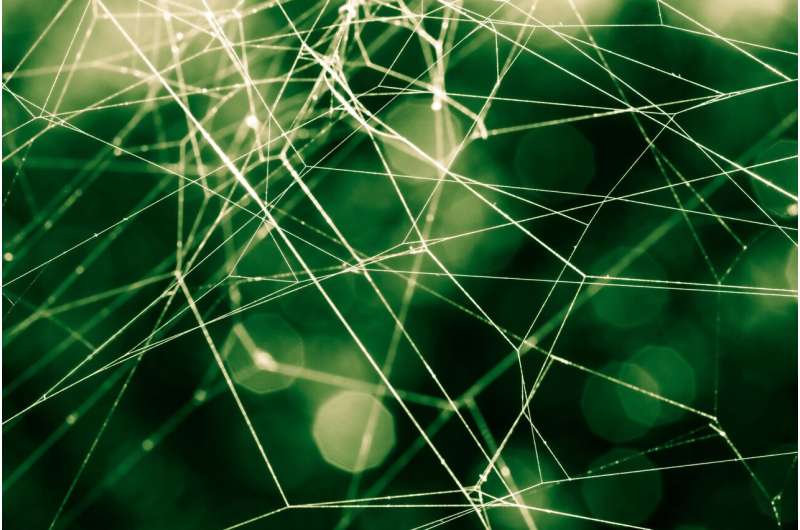September 23, 2023 report
This article has been reviewed according to Science X's editorial process and policies. Editors have highlighted the following attributes while ensuring the content's credibility:
fact-checked
trusted source
proofread
Saturday Citations: Cutting the middleman out of spider silk synthesis; hungry black holes; Osiris-Rex is back!

This week, we reported on spider silk synthesis without spiders, and how policymakers are pursuing a wish-based approach to a global economy under climate change—what the kids call "manifesting" a green-growth future. Plus, black holes could be hungrier than previously believed.
Spiders bypassed
Spider silk is a protein fiber with remarkable mechanical properties, including high tensile strength and ductility, toughness and adhesiveness. Engineers envision uses for spider silk including durable and more comfortable clothing, new kinds of bulletproof armor and biomedical applications.
Unfortunately, spiders, who only want to produce silk for a narrow corridor of spider-adjacent purposes, are standing in the way of radical advances in materials science. Instead, scientists seek a more compliant source of spider silk, a congenial and obedient organism that would do little other than eat and produce silk.
If your first thought was "golden retrievers," you're an original thinker whose work I would hang on the refrigerator. A multi-institutional collaborative of researchers in China have instead genetically modified silkworms using CRISPR-Cas9 to produce spider silk; they are a more ideal silk producer than dogs for a number of important reasons.
Package en route
To paraphrase 1970s trucker country singer Red Sovine, there's a hot load of freight bound for the Utah desert on Sunday, all the way from the 101955 Bennu asteroid. The Osiris-Rex spacecraft will deliver somewhere in the ballpark of a half-pound of space rubble via parachute-dropped sample capsule.
Osiris-Rex clocked 4 billion miles across both legs of the mission, which was punctuated by its bouncy touchdown and sample grab in October 2020. Researchers hope the sample will yield more clues about the origins of the solar system. Bennu is a member of the Apollo street gang of Earth-crossing carbonaceous hooligans, and it's regarded as a potentially hazardous object, with a 1 in 1,800 chance of impacting the Earth sometime between 2178 and 2290. Great-great grandchildren beware.
Primates fancy
By contrast with many insects and flamboyant tropical birds, mammals don't tend to exhibit flashy colors, preferring a more muted pallet of basically what you'd expect to see in a Dockers catalog. Mammals: the khakis-wearing vertebrate class. However, a small number of primates do have bright coloration like red skin and red/orange fur.
Previously, biologists believed that bright coloration corresponded with better color vision, but a new study by researchers at the University of Bristol suggests that bright coloration may also be useful for social communication within species that don't have good color vision, conveying information like fertility and social hierarchy. This was interesting to me, personally, a primate without flashy coloration or the ability to distinguish red and green.
Planet overextended
The last 50 years of global economic thought have been more or less summarized as "number goes up." As climate change alters weather patterns and induces conditions threatening to the global economic order and the concept of human survival, many academics over the last decade have advocated for a vague, hand-wavy policy of "green growth," a phrase that implies that we can still ship all the Baby Yoda Funko Pops we want around the globe in massive cargo ships with zero emissions and no negative economic or social consequences.
While policymakers have seized on this concept, a growing number of academics are expressing skepticism, instead advocating "degrowth"—a paradigm of planned reduction in material consumption—or "agrowth"—a neutral perspective on growth that instead emphasizes sustainability without regard to GDP.
Matter delicious
Competitive eaters who want to gain a performance edge might take a cue from supermassive black holes: twist surrounding space-time to rip apart the surrounding accretion disk (or tray of hot dogs).
Astrophysicists at Northwestern University have advanced this exact theory, writing that supermassive black holes may actually consume surrounding matter more quickly than previously believed. Twisting the surrounding space-time shreds the accretion disk into inner and outer rings; once the inner ring is devoured, the outer disk spills inward to replenish the consumed matter and the process repeats. If they're correct, a single cycle takes months as opposed to the hundreds of years suggested by prevailing models.
© 2023 Science X Network





















